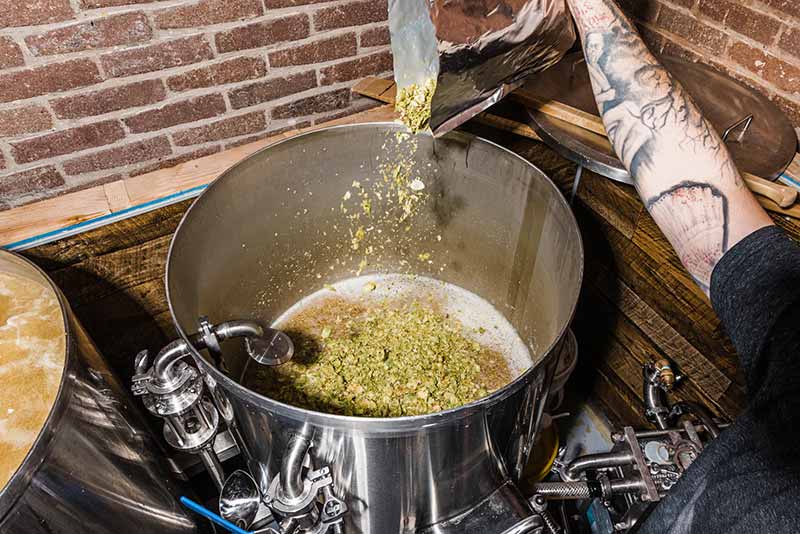
Determining where you put your hops can play a huge factor in the personality of your beer.
Throw some in the boil to build up the bitterness of your beer. Of course, those IBUs vary based on the hops’ alpha acids and the amount of time spent in the boil.
Pitch some hops into the whirlpool phase for some post-boil aromatics, as well as some contribution to the IBUs.
And dry hopping brings so much hop character to your beers in the nose and the flavor profile. Double dry hopping further accentuates that, as well.
But what about adding hops way earlier in the process—for example, in the mash? How can mash hopping add to your beers in ways that the other phases of your hop schedule can’t? Experts in mash hopping from Omega Yeast and Sapwood Cellars Brewery share all about the benefit of mash hopping, how to do it effectively, and why it could make your IPAs even juicier.
Affordable, Industry-Leading Brewery Software
What Is Mash Hopping?
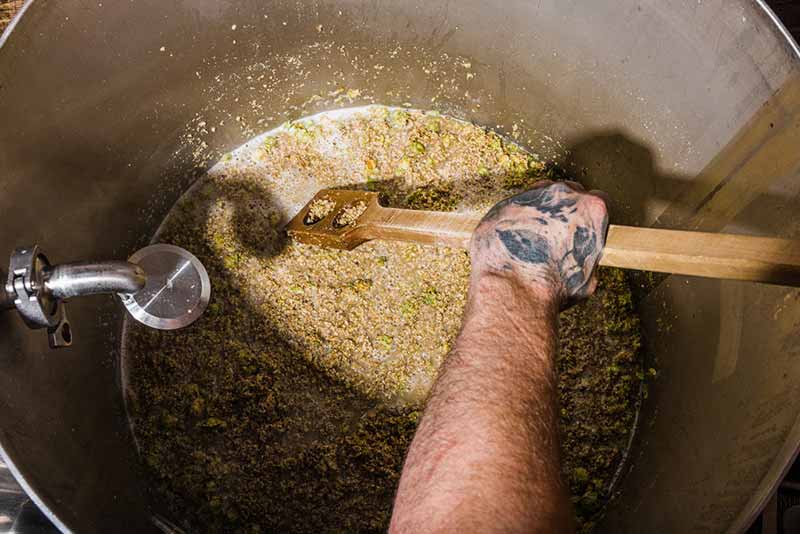
Photography courtesy of Yakima Valley Hops
Mash hopping isn’t just throwing hops into your grains. You certainly do that, but you do it with a purpose.
Mash hopping is by no stretch a new technique in brewing. But as more studies emerge, researchers find unique benefits that might intrigue brewers or entice them to try it out.
It used to be that mash hopping was mainly to add some subtleties to lighter beer styles, think lagers or pilsners. Nope, not IPAs. Those hops—you don’t throw in much for mash hopping— just get lost in the big hop-forward beers.
But now engineered yeast strains—thiolized yeast—have been created and can unlock flavors from those mash hops that traditional yeast strains cannot.
“There’s a process of biotransformation that involves yeast taking precursors from malt and hops and transforming them into free thiols in fermentation,” Omega Yeast Director of Research and Development Laura Burns says. “If the hops are introduced early in the mash, the [fruity and tropical aromatic] precursors there can be dissolved and carried throughout the whole brewing process.”
Mash hopping extracts thiol precursors, opening up their flavor and aroma potential for the consumer.
“That’s been what we found is the major advantage of mash hopping,” Burns says of the thiolized yeast and how it helps a beer during mash hopping. Some specific hops work best when coupled with thiolized yeast, like Noble hops.
But you don’t need to get a thiolized yeast strain to experience the benefit of mash hopping. Just throwing hops in the mash can help with lautering, shelf life stability, oxidization, and more.
Any hops will do in mash hopping—as long as they are not too old. Sapwood Cellars Brewery Co-Founder and Brewer Scott Janish admits if a hop doesn’t smell good enough to him for use in the whirlpool or dry hop phase, he stashes them aside strictly for mash hopping.
Janish always uses hops in the mash, following science that says the technique reduces iron counts, among other benefits.
The science is compelling for Janish. He doesn’t see any fundamental challenges to the process.
“It’s pretty straightforward,” Janish says. “And generally, honestly, it just makes the mash smell so much better.”
Three Improvements Beer Gets From Mash Hopping
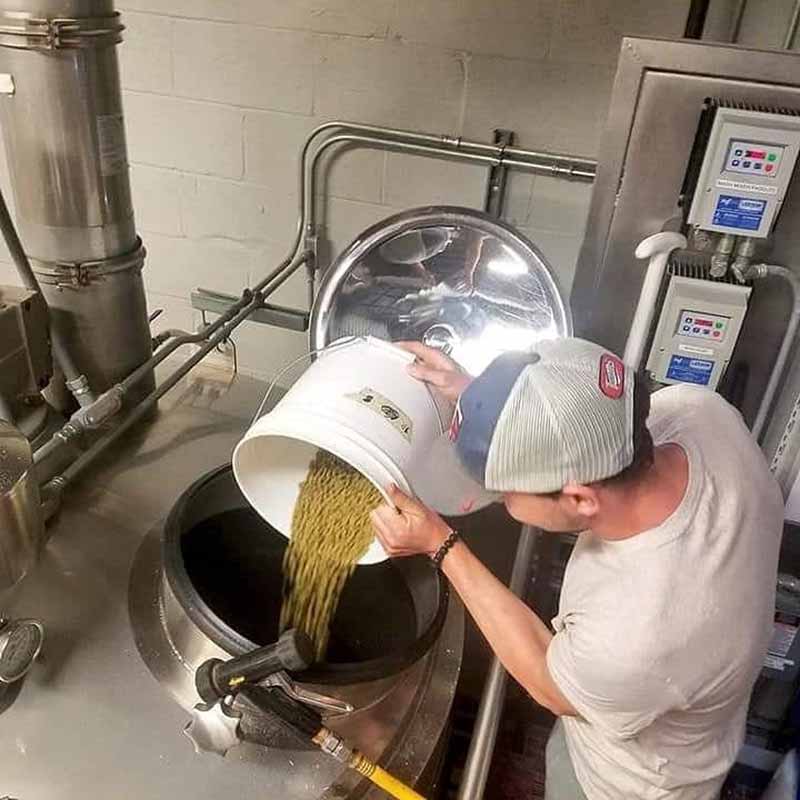
Sapwood Cellars Brewery Co-Founder and Brewer Scott Janish adds mash hops to a triple IPA | Photography courtesy of @scottjanish
When mash hopping, there are several benefits to your beer that you’ll find, according to Burns and Janish.
From a thiolized yeast perspective, Burns says mash hopping can lend to improved complexity. Janish, who admits they occasionally seek that complexity, says that all his research on mash hopping has led to him using the practice to help with iron counts and better the shelf stability of his beers.
Improved Complexity with Thiolized Yeast
Burns says that thiolized yeast strains are engineered from yeast strains brewers are already very comfortable with and can be used identically as the parent strain. But the engineered yeast is capable of more.
“These new strains are used exactly the same way,” Burns says. “They just have the new enzyme activity, so they are able to release thiols.”
She adds, “It’s effectively loading up the beer with more free thiols.”
To learn more about thiolized yeast and its effect on beer, check out our “Essential Guide to Thiolized Yeast.”
Lowers Iron Counts
Janish says that in all the reports he has read about mash hopping, adding the hops early in the brewing process can help remove metals in the malts.
Citing the study, Janish says, “Using about .4 pounds per barrel of Columbus hops in the mash … they found almost a thirty-percent reduction in iron levels when they mash hopped to get about 20 to 25 IBUs.”
He adds that the study also found a fifty-percent reduction in staling aldehydes just from mash hopping and dropping those iron levels in the beer compared to one that was not dry hopped.
“For us, it’s pretty convincing science to incorporate some mash hops for the beer,” Janish says.
Burns adds that the mash hops can lead to avoiding oxidization, which all brewers know is beer’s worst enemy.
Better Shelf Stability
The removal of metals and iron in the malts directly leads to staling improvements in the finished product, which improves the shelf life.
“Mash hopping potentially helps to add to a longer shelf life, or other benefits you’re getting, that would make a difference to me,” Burns says.
Janish says that New England IPAs are more temperamental and can oxidize more readily than other styles, so mash hopping is more critical in this particular style.
“For us, we’re [mash hopping] mainly as a way to hopefully increase the shelf life of our beer,” Janish says.
Sapwood Cellars didn’t have data to show the improved shelf life for the beers that were mash hopped versus those that weren’t, but Janish said they had sent in samples and are waiting for the results.
“We’re pretty happy with where our beers are now in terms of, you know, a couple of months still holding up for a hoppy beer, and it’s still tasting pretty good for us,” Janish says. “How much of that has to do with mash hopping, we’ll see … But for now, things are working well, and the science kind of leads us that way.”
Which Hops to Use for Mash Hopping
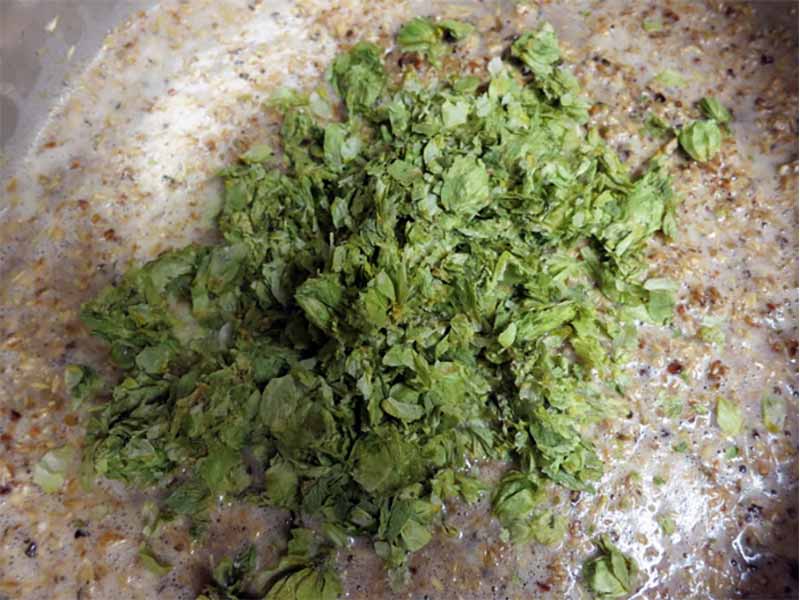
Photography courtesy of the Hop Store
Truly like a dealer’s choice, choosing a hop varietal depends on your purpose for mash hopping.
Sapwood Cellars uses mash hopping in every beer they make. It’s not an alpha acid thing or anything that will unleash some thiol precursors. For Janish, it’s simpler than that.
“There’s always some group of hops that are just not really being used for anything, like maybe you bought some hops that were meant to use in a dry hop, and you open the bag, and they just didn’t pass that sniff test,” he says. “Those are the ones we tend to use in the mash.”
Janish says Sapwood Cellars isn’t using anything super old or “cheesy,” but some middle-of-the-road hops that couldn’t find a home in any other beer they were brewing.
“We have a big box of random hops that [is labeled] ‘mash hops,’” he says.
Burns takes a different approach to the hops used for mash hopping, leaning toward hops that provide a more significant release of bound thiol precursors when used with thiolized yeast strains.
Burns says that Cascade hops and Noble hops—such as Czech Saaz, German Perle, and Hallertauer Mittelfrüh—or even Calypso or Motueka hops would be good mash hopping options in conjunction with thiolized yeast.
At What Rate to Hop for Mash Hopping

Photography courtesy of Shawn Williams | Hazy and Hoppy
You don’t need much. Whether you are working towards extracting thiol precursors or not, the amount of hops you add into the mash hopping phase is minimal.
“We recommend anywhere from a half a pound to two pounds per barrel,” Burns says.
As mash hopping goes, you extract some bitterness from a pre-boil addition, but it’s roughly a thirty-percent impact on IBUs, so alpha acids don’t need to be of great concern.
“It’s probably more about how much you’re using and thinking of it as kind of a whirlpool addition,” Burns says. “You don’t want to overdo it.”
With that in mind, Janish says he essentially writes the mash hops into his recipe. Depending on the hops, Sapwood Cellars use two to four pounds of hops in their mash hop for ten barrels—essentially from .2 to .4 pounds per barrel.
“We’re generally around twenty pounds in the whirlpool for most beers in ten barrels. And so sometimes we’ll just say ‘okay, four pounds of that will go into the mash,’ or ‘two pounds of that will go into the mash,’ and then lower the temperature of the whirlpool to hit our IBUs,” Janish says, noting the whirlpool temperature varies depending on the level of alpha acids. “So we use the whirlpool temperature to reach our IBU target, and sometimes we’ll just steal some of those whirlpool hops and throw them into the mash,” he adds.
What Yeast to Use to Complement Mash Hopping

Photography courtesy of Omega Yeast
Any yeast is fine when mash hopping. But, if you intend to free up thiol precursors and pack an aromatic punch in your beer, you’ll need to use an engineered thiol yeast.
“In malt and hops, there are the thiol precursors, which are just bound-up aroma compounds that are kind of trapped in the beer and not providing any aroma until they’re released,” Burns says. “We’ve engineered these [thiolized] yeasts to express an enzyme that can cleave off the precursor compound.”
Burns adds, “So then you get the free thiol release and access to all that aroma potential. Traditional yeasts will not have that enzyme activity and are not able to release those precursors effectively.”
Some thiolized yeast strains include Omega Yeast’s Cosmic Punch Ale and Helio Gazer Ale, derived from the British Ale V strain, and Star Party Ale, coming from the West Coast Ale I strain.
Sapwood Cellars has dabbled with thiolized yeast strains but typically uses its traditional house strain when mashing.
“It’s more of a complexity builder,” Janish says of using thiolized yeast. “When you’re using, like, a Cosmic Punch, you’re trying to push that yeast to do a little bit more … giving that yeast more of a chance to make an impact on the beer.”
He says that they don’t mash hop intending to extract those thiol precursors. However, if they did, they would opt to mash hop with hops that have higher bound thiol precursors like Czech Saaz or Cascade, he says.
What Style of Beer to Make with Mash Hopping

Photography courtesy of Craft Beer and Brewing
Sapwood Cellars utilizes mash hopping in all its beers.
“I don’t think it’s overkill to mash hop in every style of beer,” he says. “The studies show pretty significant [data on the benefits]. I think it’s worth it.”
For Burns, she says mash hopping is excellent for a West Coast, hop-forward style.
“I would like it in a West Coast style because I already know I’m already going for a bittering addition, and I want that kind of bite and backbone to it,” she says. “And kind of clean, hoppy styles that have a nice bite or backbone is a great way of using [mash hopping].”
One Last Word on Mash Hopping
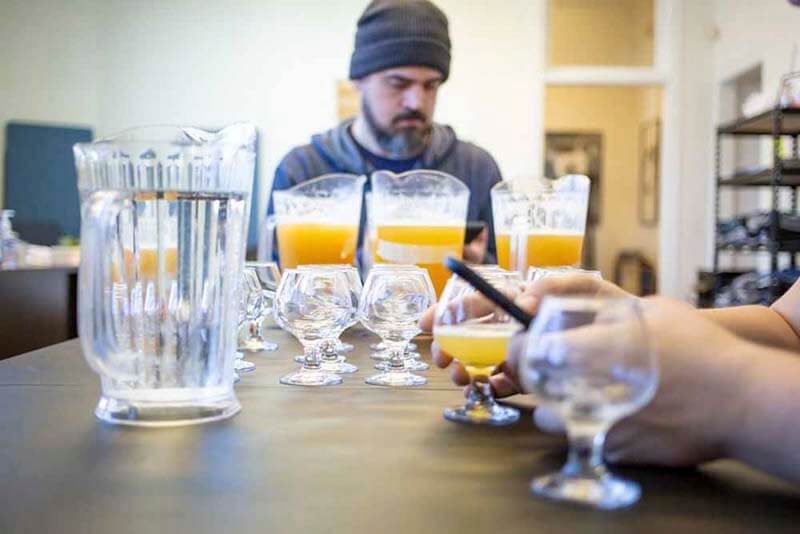
Photography courtesy of Omega Yeast
For Burns, she says definitely mash hop but added a caveat.
“If you’re going to try it, just think about [doing it with and] without, and really have a comparison for yourself,” she says. “Make those small test batches where you get to evaluate those individual changes that you make.”
Weighing all the benefits of mash hopping, Janish points out that it can lead to some peace of mind.
“It’s cheap insurance,” he says. “If there’s a chance it helps, and there’s not a big downside, it’s worth the cost.”



